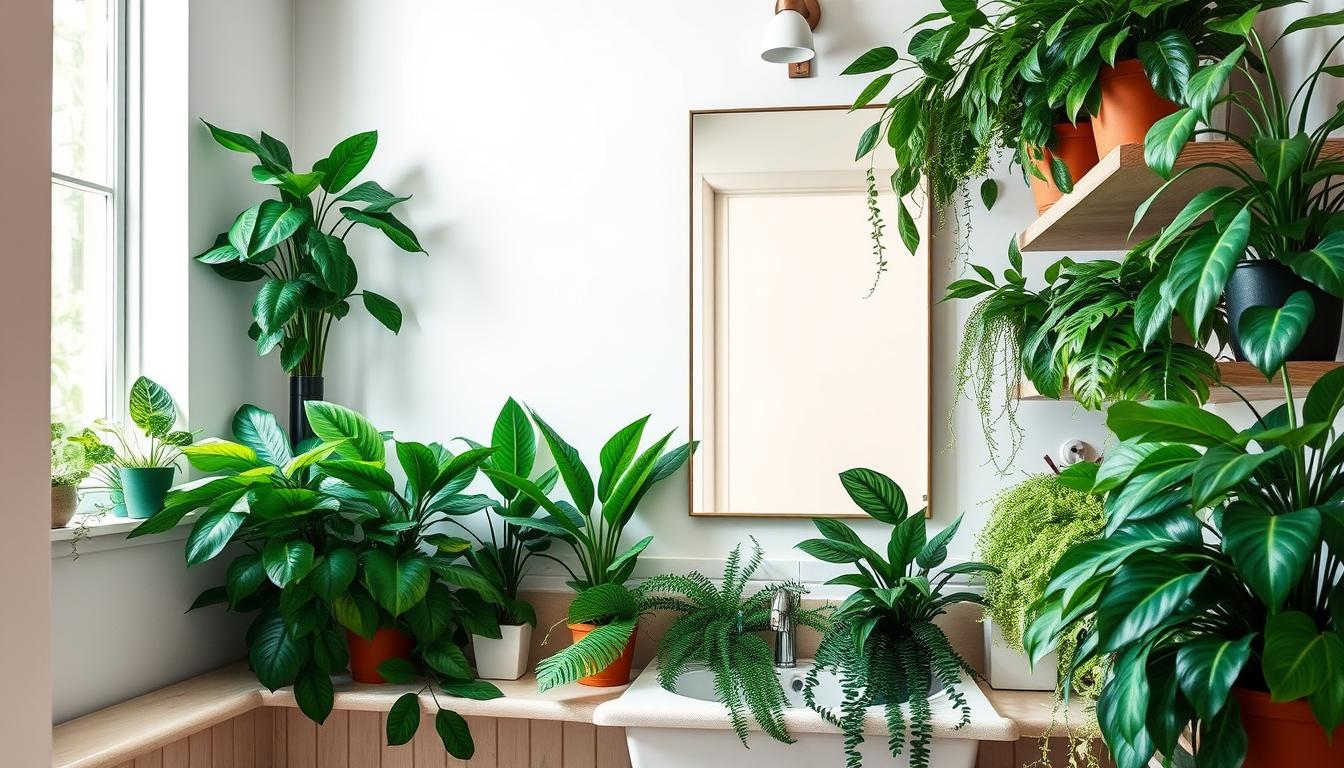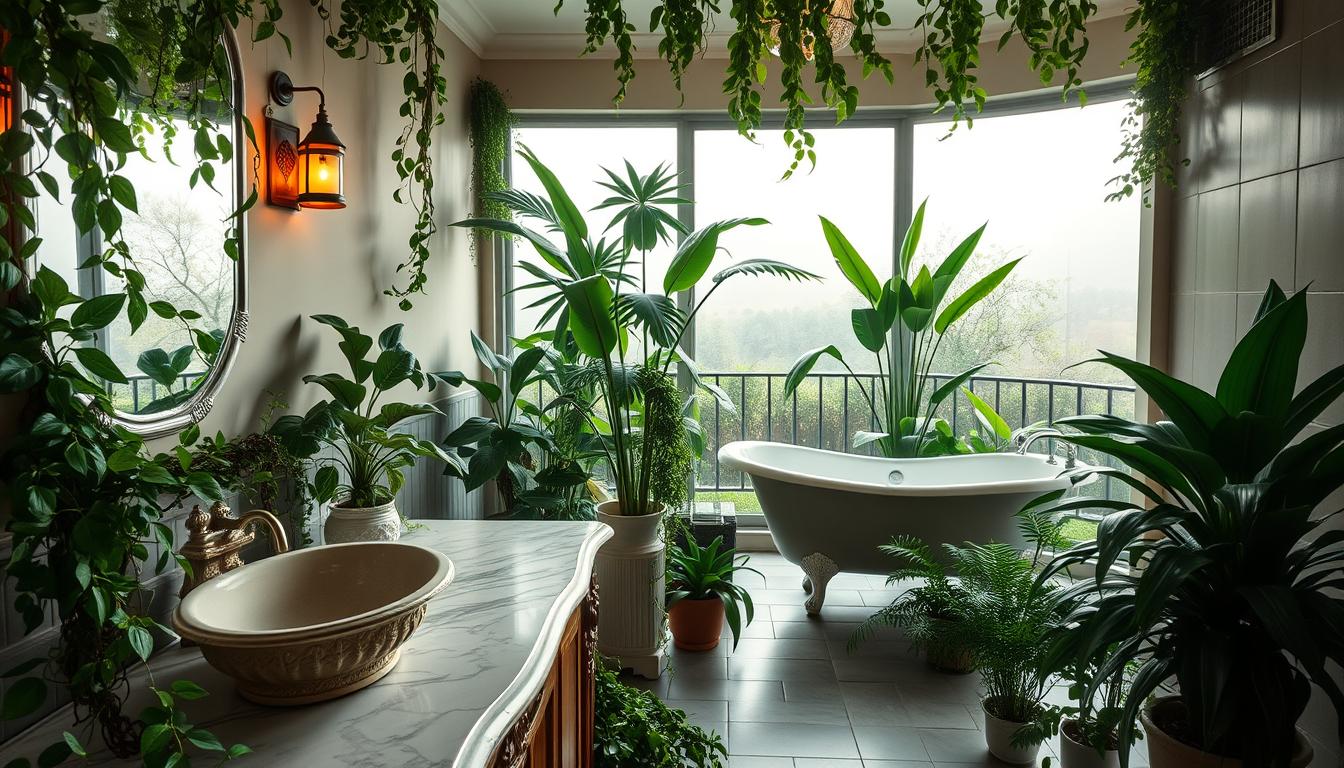Keeping your faux plants looking vibrant can seem hard. This is because dust can make them look less lively. But, static cling solutions are a great way to keep them looking fresh. By knowing how to care for them, you can make sure they always add beauty to your home. In this article, we’ll explore why dust collects on them, how to clean them properly, and the best products to use. This is especially important in places where there’s a lot of moisture.
Understanding Static Electricity and Fake Plants
Static electricity is important when caring for fake plants, especially those made of plastic. It happens when surfaces touch and then separate, moving electric charges around. Many artificial plants are from materials that don’t conduct electricity well, so they get static easily.
The way plastic surfaces interact with their surroundings also affects static buildup. In dry air, static charges build up more, which makes dust stick to fake leaves. But, when the air is moist, static charges are less because electrons move easier. Knowing this helps in keeping your fake plants clean and looking good.
The Importance of Cleaning Fake Plants
Cleaning fake plants regularly is key for their looks and life span. Dust can make them look faded and unwelcoming. Good cleaning keeps them looking nice and helps stop dust buildup, which is good for your health.
Fake plants can trap allergens, which may be harmful to your health. Cleaning them well keeps them safe and pretty in your space. The way you clean them matters; the right steps keep them looking new.
Taking care of your artificial plants stops hard-to-remove dust from gathering. This makes cleaning them later easier. With some care, they’ll make your home look great for a long time.
Common Causes of Dust Accumulation on Faux Foliage
Dust can pile up on fake plants because of different things around us. Air quality is a big factor, with indoors stuff like smoke, pet fur, and dust from us moving around. Also, these fake plants often sit in spots where dust easily gets to them, leading to more dust over time.
The stuff fake plants are made of can pull in tiny dust particles. This makes the dust problem worse. Outdoor air, especially in cities, brings more tiny bits that end up on these plants. Knowing why helps us clean our fake plants better, so they always look nice.
Benefits of Using Static Cling Solutions for Dusty Fake Plants in Moist Environments
Static cling solutions play a key role in keeping dusty fake plants clean, especially where it’s humid. Humidity increases static electricity. This makes dust stick to fake plants more. Cleaning them becomes harder.
These cleaning products are made to fight static. They repel dust and create a barrier to stop dust from gathering. Not only do they keep the plants clean, but they also keep them looking vibrant and appealing.
In places with lots of humidity, using antistatic sprays is smart. They keep dust away and make your fake plants seem fresh and real for longer. These solutions lower static on your plants. So, they don’t get dusty so quickly. This helps improve the air and look of your indoor spaces.
Regular Dusting Techniques to Maintain Fake Plants
Fake plants need regular care to look good. This means paying attention to dust buildup. Using various cleaning methods and tools helps keep your fake greenery vibrant and fresh.
Basic Dusting Methods
To make fake plants look better, try these simple cleaning steps:
- Lightly tap the plant to dislodge dust particles.
- Gently wipe surfaces using a microfiber cloth.
- For intricate details, use a soft brush to avoid damage.
Recommended Dusting Tools
Choosing the right tools is key for good maintenance. Use these tools for best results:
- Extendable dusters for hard-to-reach areas.
- Microfiber cloths that trap dust efficiently.
- Lambswool dusters which are gentle on delicate faux foliage.
- Vacuum cleaners with minimal suction settings to prevent harm.
Citrus Solutions: A Natural Approach
Making a DIY citrus solution is a smart, earth-friendly way to clean artificial plants. Just mix lemon juice with water in a spray bottle. This creates a gentle cleaner that not only takes off dust but also makes your space smell good. It’s perfect for faux plants, making them look better without any harsh stuff.
Before you use the citrus cleaner, remember to dust first for the best results. Dusting stops more dust from gathering and keeps your fake plants looking bright. Keeping up with this routine means the citrus solution will be more effective. It helps keep your artificial plants looking clean and beautiful.
Salt Treatment for Stubborn Dust
The salt treatment shines in getting rid of tough dust on fake plants. You put the faux plants in a resealable bag full of coarse salt. Seal it and shake gently. This gets the salt to knock off stubborn dust and dirt from the plant’s surfaces.
This method cleans faux plants well without harming them. If you’re looking for another option, cornmeal works like salt. It cleans in a similar way. Using the salt treatment regularly takes away dust. It also keeps the plant looking bright and stylish.
Soapy Water: An Effective Cleaning Method
Using soapy water is a top way to clean fake plants. This is especially true for those that aren’t too delicate. Mixing some mild soap with cool water gets rid of dust and dirt well. But remember, hot water can damage the plant materials.
For cleaning, either dip your faux plants in this mix or dab them with a soft cloth. This keeps them looking fresh and clean. After, be sure to rinse them off with clean water to get rid of soap traces. Drying them well is key to stop any water harm and keep your faux plants looking great.

Exploring Antistatic Cleaning Agents
Antistatic cleaning agents are key for keeping faux plants looking great. They target static electricity that pulls in dust and dirt. This helps stop dust from gathering on your fake plants.
When choosing antistatic cleaning solutions, pick ones made for artificial materials. Using them regularly keeps faux plants looking fresh. In places with dry air, these products are even more important. They repel dust, making cleaning simpler and helping your faux plants last longer.
Preventing Static Build-Up on Fake Plants
Looking after fake plants means taking steps to stop static. It’s all about keeping electrostatic charges low. Increasing air moisture is a smart move to prevent static electricity. Also, using the right cleaning cloths is key to less dust.
Methods to Increase Humidity
There are several ways to keep the air moist around your fake plants. Here are some:
- Misting machines spread water evenly in the air.
- Humidifiers make the air in rooms more moist.
- Water in shallow dishes near your plants also helps increase humidity, cutting down on static.
Choosing the Right Cleaning Cloths
It’s important to pick cleaning cloths that fight static. Cloths made to stop static help a lot with dust control. Microfiber cloths work well because they trap dust without making more static. Anti-static cloths also protect against dust sticking to your plants.
Static Cling Solutions for Dusty Fake Plants in Moist Environments
Maintaining dusty fake plants in moist places can seem hard. Yet, static cling solutions provide an effective way to tackle this. These products make a shield to stop dust from sticking to your fake plants. Adding them to your cleaning routine can make your faux plants look better.
Static cling solutions keep away dirt and dust. They also keep the colors and textures of fake plants bright in humid areas. In places with a lot of moisture, these products are really helpful. They make it easy to keep your fake plants looking new.
Using static cling solutions with regular cleaning lessens the need for deep cleaning. This method not only saves time but also makes your space more welcoming. It’s a straightforward way to care for your fake plants.
Conclusion
Cleaning fake plants well helps them look good and last longer. Using special cleaners made for fake plants is key. Keeping them dust-free and managing static helps them stay vibrant.
Caring for fake plants gets easy with the right cleaning solutions. Adjusting your approach based on humidity can make a big difference. With careful attention, fake plants will keep beautifying spaces for a long time.



